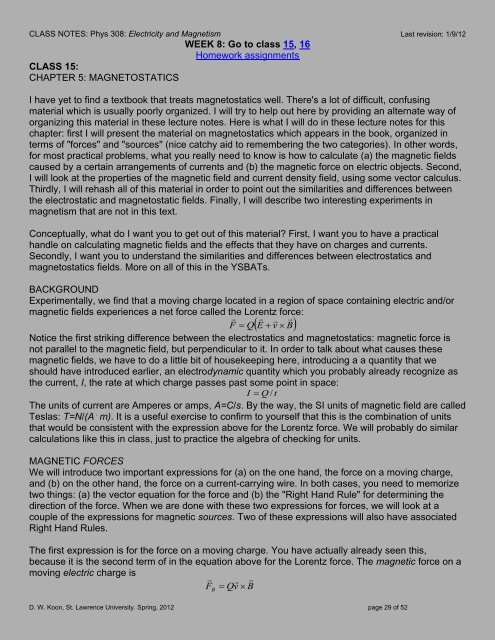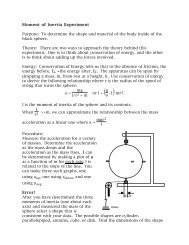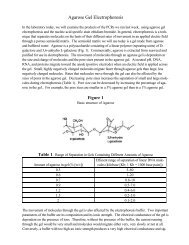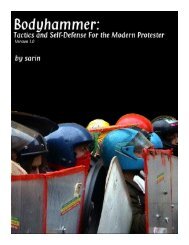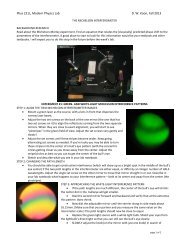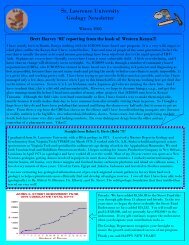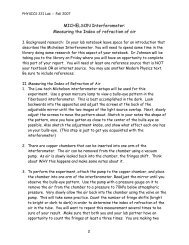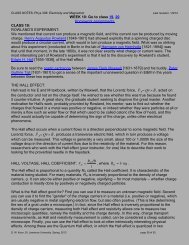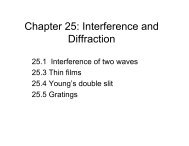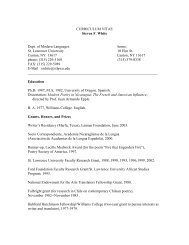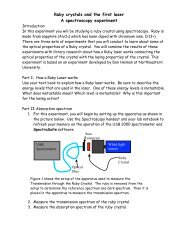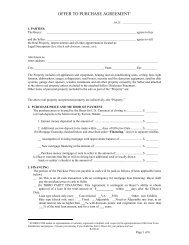PHYS 308 LECTURE NOTES, Daniel W. Koon, St. Lawrence Univ ...
PHYS 308 LECTURE NOTES, Daniel W. Koon, St. Lawrence Univ ...
PHYS 308 LECTURE NOTES, Daniel W. Koon, St. Lawrence Univ ...
- No tags were found...
Create successful ePaper yourself
Turn your PDF publications into a flip-book with our unique Google optimized e-Paper software.
CLASS <strong>NOTES</strong>: Phys <strong>308</strong>: Electricity and Magnetism Last revision: 1/9/12Now consider a wire which is carrying electric current. We can picture this as containing a stream ofelectric charges travelling down the length of the wire with some velocity, v. There ought to be someforce acting on these charges. One can show that the equation for the force on a moving chargeyields this expression for the force on a current-carrying wire:F IlBsinMagnetic deflection of TV tubehttp://www.youtube.com/watch?v=s1xS-ssfTM8Lorentz force on a wirehttp://www.youtube.com/watch?v=_X8jKqZVwoINow for the "Right Hand Rules". Here, the order in which we write the terms on the right hand side isvery important. Since these are cross products, we simply use the right hand rules for a crossproduct. There are a number of ways of stating the Right Hand Rule, differing from textbook totextbook and instructor to instructor. I will give you my version, but you should feel free to come up with your own expression, as long as it is consistent with mine. If we have a vector C AB , you canfind the direction of C by a pointing your fingers in the direction of A and then slapping them in thedirection of B . Now, if you put your fingers pointing in the direction of A , your palm will be facing inany one of a variety of directions. But there is only way you can point your palm so as to be able toslap in the direction of B without straining your wrist (i.e. without slapping more than 90 o ). So, afteryou point our fingers toward A , you have to orient your palm in such a way that you can slap in thedirection of B . Once you have done all of that, you find that your thumb is pointing in the direction ofthe vector C .Incorrect application of righthand rulehttp://files-cdn.formspring.me/photos/20120106/n4f06db36057c8.jpg.Accessed 1/9/12.Correct application of the righthand rule:A is to our left (penguin‟s right).B is forward for the penguin.Therefore C points straight up (if penguin had a thumb).http://www.youtube.com/watch?v=2DB7Jm0m-jUTo recap, to find the direction of the force on a moving charge, point your fingers in the directions ofQV, and slap in the direction of the magnetic field, B . To find the direction of force on a currentcarryingwire, point your fingers in the direction of the current and then slap in the direction of B . Ineither case your right thumb points in the direction of the force. Any of you who are left-handed willhave an easier time because you can continue to take notes while your right hand is figuring out thedirection of force.D. W. <strong>Koon</strong>, <strong>St</strong>. <strong>Lawrence</strong> <strong>Univ</strong>ersity. Spring, 2012 page 30 of 52
CLASS <strong>NOTES</strong>: Phys <strong>308</strong>: Electricity and Magnetism Last revision: 1/9/12CLASS 16:MAGNETIC SOURCESThe two principal sources of magnetic fields we will discuss are both current carrying wires. One issimply a straight length of wire; the other is a circular loop. At a distance r from the axis of the straightwire -- as long as r is much less than the length of the wire -- the magnetic field equals0IB 2rwhere 0is a constant known as the "permeability of free space" which is equal to720 4 10N / A . It is a useful exercise to confirm that the units on the lefthand and righthandsides of the equation equal.Notice that this is not a vector equation. This means that we need some way of determining thedirection of the field. We will introduce the appropriate Right Hand Rule soon.<strong>St</strong>raight long wires are not very useful if you're trying to design your own electromagnet. Themagnetic field extends into all of space, and falls off very slowly. But most importantly, you wouldneed a very strong current in order to get any sort of decent magnetic field anywhere except rightnext to the wire. A much more effective source for the magnetic field is a circular coil. The equationfor the field near a circular coil is generally messier than for the field near a long straight wire.However, I will give you an expression for the magnetic field at the center of the coil, and then, foryour own future reference, an expression for the magnetic field along the axis of the coil. For a coil ofradius R, the magnetic field in the center equalsB 0I2RFor that same coil, the magnetic field along its axis, at a distance z from the plane of the coil, is givenby20IRB 2 z2 2R 3/ 2Now a single coil is not a very good electromagnet either. The field drops off quickly along its axis.There are two common ways of getting around this. One is called a solenoid. In this, we wrap wiresaround a cylindrical form, so that we are simply adding a large number of single coils together, eachof them displaced along the z-axis from each other. If the solenoid is sufficiently long, then themagnetic field inside the solenoid can be made nearly constant, equal toB nI NI / l0 0where n = the number of coils per length of the solenoid, n=N/L, where N = the total number of coils inthe solenoid, and L = the total length of the solenoid. In order to approach this limit, you need to fulfillthe following conditions: the solenoid must be much longer than it is wide, and you must bemeasuring the magnetic field close to the axis of the solenoid.Another improvement over the single-coil electromagent is to put two coils (each of radius R) aD. W. <strong>Koon</strong>, <strong>St</strong>. <strong>Lawrence</strong> <strong>Univ</strong>ersity. Spring, 2012 page 31 of 52
CLASS <strong>NOTES</strong>: Phys <strong>308</strong>: Electricity and Magnetism Last revision: 1/9/12distance R from each other along the same z axis. This arrangement is called a Helmholtz coil. Thisis particularly useful if you don't need a very large magnetic field, but you need the field to berelatively uniform in the volume surrounding the center of the coils. We'll explore this uniformity in a"Daily" problem.RIGHT HAND RULES FOR MAGNETIC SOURCESThe Right Hand Rules for these two sources --- the long straight wire and the single coil --- are similarto each other but quite different from the right hand rules we developed for magnetic forces. Thoseright hand rules involved slapping; these right hand rules involve holding your right hand with thefingers curled and the thumb pointing straight out. (more like hitchhiking than slapping) The only twoquantities involved are the current and the magnetic field. So these Right Hand Rules are fairly easyto remember. If the current is pointing in a straight line, point your thumb in that direction and thefingers will curl in the direction that the magnetic field curls around that wire. If the current is pointingin a loop, curl your fingers in the direction in which the current curls, and your thumb will point in thedirection of the magnetic field inside that loop.The hardest part is wrapping your brain around the idea that the B-field surrounding a long, currentcarryingwire points in a circle. So let's consider a simple example. Imagine a power line, many feetabove the ground, in which the current points east. On the ground, the B-field points north. Above thewire, the B-field point south. At the height of the wire, but south of the wire, the B-field points towardthe ground. And at the height of the wire, but north of the wire, the B-field points straight up. In eachcase, in order to figure out the direction of the B-field, you begin by pointing your thumb in thedirection that the current points, namely East, and then putting your fingers in the direction at whichyou want to measure the direction of the field. If you want to know the direction of B on the ground, forexample, point your thumb towards the east with your palm facing north, so that your fingers arebelow your thumb, and you will see that they are curling towards the north. Work through thisexample to see whether or not you get it. If not, come to class with a bunchload of questions.THE LAW OF BIOT AND SAVARTIt will seem that we have skirted the real, basic issue here: what is the magnetic analogue ofCoulomb's law? The reason we have skirted this is that the equation is much uglier than Coulomb'slaw. The reason for this is that the source of any magnetostatic fields is a current, and there is nosuch thing as a "point current", as there is a "point charge". This suggests that in order to calculate amagnetic field, we will always need to integrate something. The other problem is that the magneticfields created by a current is always perpendicular to the direction of that current. As a result theequivalent of Coulomb's Law for magnetostatics, the Law of Biot and Savart, has the following, uglyform: dB 4r0 Idl rˆ2Here I have given you the differential form, unlike the integral which the book gives you, becausefrankly this is a bit less ugly and it more closely resembles Coulomb‟s Law.Go to YSBATsD. W. <strong>Koon</strong>, <strong>St</strong>. <strong>Lawrence</strong> <strong>Univ</strong>ersity. Spring, 2012 page 32 of 52


